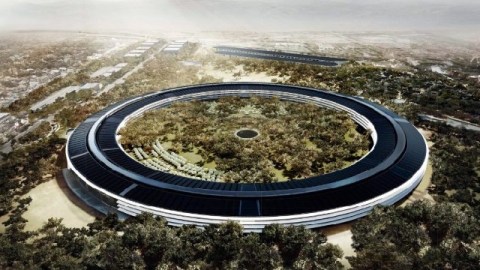Are Tech Giants’ Offices the Cathedrals of the Future?

On October 15, 2013, the City Council of Cupertino, California, debated for 6 hours before finally approvingApple’s plans for a new $5 billion USD office headquarters to be built in their city. Apple’s then-CEO Steve Jobs approved architect Norman Foster’s design (shown above) just weeks before his death in 2011. Work on the mammoth “mother ship” begins next year and is scheduled to be finished sometime in 2016. For a company that likes to “think different,” this architectural thinking looks more like old school thinking to me, specifically the kind of “bigger is better” mentality that spawned the building of massive cathedrals throughout Europe for centuries. Whereas the old churches rose in worship of the old gods, these new churches rise up in worship of the new tech corporate gods. Are the tech giants’ offices the cathedrals of the future?
Foster’s building, officially called Apple Campus 2, will stand just one mile east of the current headquarters. The plans (which can be seen here) call for a four-story circular building of 2.8 million square feet with an extensive “orchard” green area in the middle. Thirteen thousand employees will enjoy a 3,000-seat café, 1,000-seat auditorium, fitness center, and other corporate-provided amenities. Amazingly (and expensively) every pane of glass in the building will be curved to comprise the giant circle. In accordance with the new “open” floor plan fad, there will be plenty of structurally created opportunities for workers to bump into one another and interact creatively.
Apple’s not alone in this corporate cathedral building. In a recent article in the German magazine Der Spiegel, Thomas Schulz outlined this trend of “new monuments to digital domination.” Mark Zuckerberg of Facebook hired architect Frank Gehry to create “the largest open office space in the world” consisting of a single room for 3,400 Facebook employees to creatively collide. Not to be outdone, Jeff Bezos of Amazon wants architectural firm NBBJ not just to build a lavish headquarters, but a lavish biosphere headquarters consisting of three glass-and-steel domes each with their own artificial ecosystem, including a “microclimate” and “corresponding botanical zone.” NBBJ will also create Google’s new HQ, called “Bay View,” that seems almost humble by comparison, with just nine linked buildings featuring rooftop landscaped parks stretched across acres of restored wetlands.
As Schulz points out, these buildings give physical form to corporate philosophy. He calls these new offices “monuments, architectural techno-visions that reflect the now inexorable digital domination” of these few companies and “an expression of the worldwide economic and cultural supremacy that Silicon Valley and its leaders overtly claim for themselves.” The new Masters of the Universe need appropriate digs to show everyone who had any doubt who’s really in charge. The shared emphasis on “close proximity—the lack of barriers and the loss of individual private space—[is] an expression of the double-edged digital culture… [in which] the Internet creates newfound freedom, [but] people have no right to a private life.” Schulz points out this “intriguing paradox… [that] combines a disciplined domination of the market with the freedom of the creative hippie artist.” The end result, Schulz argues is “a peculiar ideological mixture of right-wing and left-wing, ultra-individualistic and ultra-capitalistic beliefs, ranging from liberalism to anti-statism…. spiced with a good pinch of techno-determinism.” These techno-determinists preach that “everyone can become rich and hip, and the world will be a better place, if you just let us do our thing.” Believe in us, Apple, Facebook, and other giants say, and we’ll take care of everything.
Is this belief-driven system backed up by large-scale symbolic building that sounded alarm bells for me—cathedral bells, if you will. Anyone who’s been on vacation to Europe has probably visited the remnants of the “arms race” of the Middle Ages during which towns would compete to have the biggest, tallest, most ornate cathedrals ostensibly in praise of the Christian god, but in no small measure as indicators of civic status and pride. With a social hierarchy shaped and maintained by the religious status quo, such buildings served as continual, “can’t miss” reminders of who’s the boss, both in heaven and on Earth. Of course, such buildings provided benefits to the lower classes, including providing the precious few glimpses of literacy and art for the majority of people. Are our iPhones and iPads so much different now from those benefits passed down from on high?
But are the masses ready to accept the new Apple and Facebook religion? Schulz points out that the surrounding non-tech-employed citizenry often resents how such big buildings trigger a corresponding influx of high-paid corporate employees that raise the cost of living beyond the means of those who previously lived there. “People rant about the techno-hipsters and their private bus lines, about the outrageously expensive apartments and rapidly rising cost of living. And they poke fun at the gigantomania of the Apple spaceship,” Schulz writes. “No one is seeking an open confrontation with this all-dominating industry, though.” At least not yet.
If Apple’s new “mother ship” is the cathedral of the future towering over our lives and enforcing the new corporate faith, who will be the “Martin Luther” posting his or her Ninety-Five Theses to the curved glass walls of these symbols (or, more modernly, posting them on social media)? Will there be a digital “Protestant Reformation” to take on these icons of the information age? Who will reclaim the rights to privacy, digital and otherwise, that Facebook and others have eroded (and the NSA has secretly stolen)? Maybe these buildings are the cathedrals of the future, but perhaps they’ll follow the Middle Ages’ cathedrals’ example and become one day the tourist attractions of a time and a mindset of a discarded past.
[Image: Architect Norman Foster’s design for the future headquarters of Apple to be built in Cupertino, California. Image source.]




